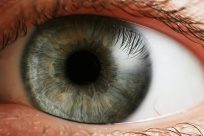 What marvelous things our eyes are. Of all the five senses, vision is perhaps the most important, with 80% of the information we obtain regarding the world around us coming entirely through eyesight. Our eyes collect information about the size, shape, color, and texture of objects. They permit us to have depth perception, judge distances to objects, as well as inform us whether an object is stationary or moving. If the object is moving, our eyes let us know its direction and its relative speed of motion. Our eyes also allow us to perceive the beauty of a sunset and pick up on non-verbal communication signals such as facial expressions or hand gestures. Our eyes function in daylight as well as in darkness and, on clear, dark nights, we can stand rapt in awe as we gaze upon thousands of stars spread across the dome of the sky.
What marvelous things our eyes are. Of all the five senses, vision is perhaps the most important, with 80% of the information we obtain regarding the world around us coming entirely through eyesight. Our eyes collect information about the size, shape, color, and texture of objects. They permit us to have depth perception, judge distances to objects, as well as inform us whether an object is stationary or moving. If the object is moving, our eyes let us know its direction and its relative speed of motion. Our eyes also allow us to perceive the beauty of a sunset and pick up on non-verbal communication signals such as facial expressions or hand gestures. Our eyes function in daylight as well as in darkness and, on clear, dark nights, we can stand rapt in awe as we gaze upon thousands of stars spread across the dome of the sky.
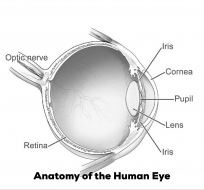 While our eyes function as light sensors, it is our brains that make sense of the information being fed to it. As the light impinges upon the sheet of photosensitive tissue known as the retina, and located at the very back of our eyeballs, the light gets transformed into electrical signals, which are then sent along our optic nerve to the brain for processing. In a very real sense, our eyes are the brain’s windows not only upon our immediate surroundings but to the Universe at large. Your eyes are the most basic set of astronomy gear that you possess and for this month’s blog, I want to do something a little different by paying tribute to the eye.
While our eyes function as light sensors, it is our brains that make sense of the information being fed to it. As the light impinges upon the sheet of photosensitive tissue known as the retina, and located at the very back of our eyeballs, the light gets transformed into electrical signals, which are then sent along our optic nerve to the brain for processing. In a very real sense, our eyes are the brain’s windows not only upon our immediate surroundings but to the Universe at large. Your eyes are the most basic set of astronomy gear that you possess and for this month’s blog, I want to do something a little different by paying tribute to the eye.
WHERE’D YOU GET THOSE PEEPERS?
 Most animals have functioning eyes (although there are some species that have secondarily lost or reduced their eyes over the course of evolution), and we know from the fossil record that eyes go as far back as 540 million years when, for reasons we still do not quite understand, complex multicellular organisms suddenly appear in a wide diversity of body plans and lifestyles. Among this dazzling array of ocean dwelling critters were trilobites. Resembling the modern-day terrestrial arthropods many of us know as roly-polys, pill bugs, or wood lice, trilobites possessed remarkably complex compound eyes. Each individual component of their eyes had its own lens made of calcite that gathered information and passed it on to the brain which then formed a mosaic-like image of the trilobite’s immediate environment.
Most animals have functioning eyes (although there are some species that have secondarily lost or reduced their eyes over the course of evolution), and we know from the fossil record that eyes go as far back as 540 million years when, for reasons we still do not quite understand, complex multicellular organisms suddenly appear in a wide diversity of body plans and lifestyles. Among this dazzling array of ocean dwelling critters were trilobites. Resembling the modern-day terrestrial arthropods many of us know as roly-polys, pill bugs, or wood lice, trilobites possessed remarkably complex compound eyes. Each individual component of their eyes had its own lens made of calcite that gathered information and passed it on to the brain which then formed a mosaic-like image of the trilobite’s immediate environment.
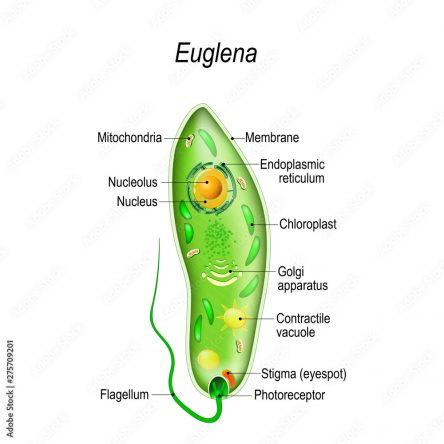 But eyes must surely have a longer history than this. Unfortunately, the fossil record doesn’t reveal much information in this regard. To fill in the gaps of the story, we must look to modern day organisms to provide us clues. The simplest light detectors are to be found in single-celled organisms such as Euglena. There are many kinds of Euglena but the one many of us are familiar with are the ones often found in ponds. They have a whiplike structure called the flagellum, used to propel this unicellular critter through the water, and they possess both animal and plant characteristics. For example, when behaving like an animal, Euglena will engulf food particles in a process known as phagocytosis and when they behave like plants, they can manufacture their own food via photosynthesis. At the base of the flagellum is a light sensitive patches known as a “stigma” or“eyespot”, which is incapable of forming any kind of image but is very useful in steering Euglena either away from or towards light. Eyespots of one sort or another can also be found in more complex multicellular creatures such as jellyfish and flatworms.
But eyes must surely have a longer history than this. Unfortunately, the fossil record doesn’t reveal much information in this regard. To fill in the gaps of the story, we must look to modern day organisms to provide us clues. The simplest light detectors are to be found in single-celled organisms such as Euglena. There are many kinds of Euglena but the one many of us are familiar with are the ones often found in ponds. They have a whiplike structure called the flagellum, used to propel this unicellular critter through the water, and they possess both animal and plant characteristics. For example, when behaving like an animal, Euglena will engulf food particles in a process known as phagocytosis and when they behave like plants, they can manufacture their own food via photosynthesis. At the base of the flagellum is a light sensitive patches known as a “stigma” or“eyespot”, which is incapable of forming any kind of image but is very useful in steering Euglena either away from or towards light. Eyespots of one sort or another can also be found in more complex multicellular creatures such as jellyfish and flatworms.
Over time, a depression around the eyespots evolved, making the organism’s vision a little better by improving the ability to not only detect the direction of a light source but movement as well, an important advantage in the deadly game of predator versus prey. Eventually there arose an organism that had the depression around their eyespots closed to a point, effectively becoming a pinhole camera of sorts. Eyes became increasingly more sophisticated until, finally, there appeared the complex eyes of trilobites and many other arthropods (animals with chitinous exoskeletons, segmented bodies, and jointed appendages such as crabs, spiders, and insects). But according to the fossil record, the evolutionary leap from these simple kinds of eyes to more complex ones like ours (i.e. with a sclera, pupil, lens, and retina) took only about 30 million years which, I hate to even say it, was a blink of the eye in terms of the long history of life on Earth. For a long time, biologists thought that with so many kinds of eyes and ways of seeing, that vision must have arisen independently within several different lineages of organisms. But recent studies in genetics and biochemistry have revealed that all these different ways of seeing share a group of light sensitive proteins known as “opsins “ which strongly suggests that eyes have a common ancestry.
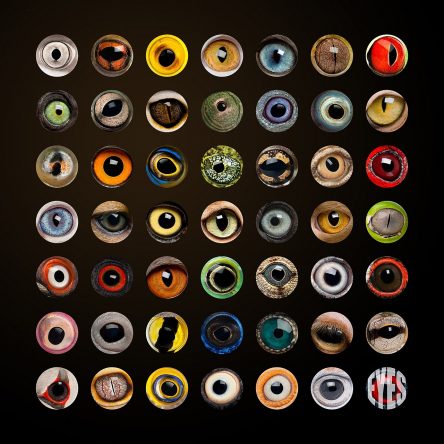 I don’t want to give the wrong impression that evolution proceeds towards specific goals or endpoints, it has no direction whatsoever, no matter how it may appear in hindsight as we look through the fossil record. Evolution is the change brought about by the inherited traits of a population of organisms over time and, as such, the process is blind with no ultimate or proximate goals in mind. So, don’t get the idea that the human eye is the pinnacle of evolutionary perfection because there are many examples throughout the animal kingdom of eyes that far outmatch our own. Eagles for example can see quite clearly for about eight times as far as your eye can, allowing them to spot a rabbit, camouflaged in its surroundings, two miles away. Dragonflies have as many as 30,000 facets in each eye and they can see polarized and ultraviolet light, forms of light invisible to our eyes. Mantis shrimp possess some of the most remarkable eyes in the animal kingdom. Their eyes are composed of tens of thousands of individual elements allowing them to perceive the world through 12 channels of color along with UV and polarized light. The human eye can process only three channels of color: red, green, and blue. The largest eyes in the animal world are said to belong to the colossal squid (Mesonychoteuthis hamiltoni). These squid have eyes that are the size of soccer balls, making them efficient light collectors, allowing the squids to detect the movement of prey, as well as predators such a sperm whales, in total darkness as they eke out their living at great depths in the Southern Ocean.
I don’t want to give the wrong impression that evolution proceeds towards specific goals or endpoints, it has no direction whatsoever, no matter how it may appear in hindsight as we look through the fossil record. Evolution is the change brought about by the inherited traits of a population of organisms over time and, as such, the process is blind with no ultimate or proximate goals in mind. So, don’t get the idea that the human eye is the pinnacle of evolutionary perfection because there are many examples throughout the animal kingdom of eyes that far outmatch our own. Eagles for example can see quite clearly for about eight times as far as your eye can, allowing them to spot a rabbit, camouflaged in its surroundings, two miles away. Dragonflies have as many as 30,000 facets in each eye and they can see polarized and ultraviolet light, forms of light invisible to our eyes. Mantis shrimp possess some of the most remarkable eyes in the animal kingdom. Their eyes are composed of tens of thousands of individual elements allowing them to perceive the world through 12 channels of color along with UV and polarized light. The human eye can process only three channels of color: red, green, and blue. The largest eyes in the animal world are said to belong to the colossal squid (Mesonychoteuthis hamiltoni). These squid have eyes that are the size of soccer balls, making them efficient light collectors, allowing the squids to detect the movement of prey, as well as predators such a sperm whales, in total darkness as they eke out their living at great depths in the Southern Ocean.
THE HUMAN EYE AND STARGAZING
 As your eyes take in the world around you, the information that they are gathering comes in the way of photons, those discrete quanta of light that behave as both particles and waves. Objects may be emitting photons, like a light bulb for example, or reflecting them, like the photons being emitted by the light bulb are bouncing off various objects in a room. Physicists recognize four fundamental forces in nature: the gravitational force, the weak nuclear force, the strong nuclear force, and the electromagnetic force. Each of these forces has a carrier force particle associated with it, which act as the method by which a given force transmits itself to other particles they are affecting. We won’t go into too much depth here but just know that photons are the carrier force particle for all forms of light, otherwise known as electromagnetic radiation. The forms of light in the electromagnetic spectrum range from short wavelength, high energy gamma rays and x-rays to longer wavelength, low energy radio waves and microwaves. The human eye has evolved to only perceive a very narrow sliver of wavelengths (and their associated photons) within the middle of the electromagnetic spectrum, namely wavelengths in the range of 380 to 720 nanometers (one nanometer is equal to one billionth of a meter). We are blind to all the other varieties of light outside of these ranges and the ridiculously narrow section of electromagnetic waves that we can detect is otherwise known to us as “visible light”. It is a testament to science and human ingenuity that we have invented detectors to act as supplements to our eyes to learn about a universe that broadcasts itself across the entire electromagnetic spectrum.
As your eyes take in the world around you, the information that they are gathering comes in the way of photons, those discrete quanta of light that behave as both particles and waves. Objects may be emitting photons, like a light bulb for example, or reflecting them, like the photons being emitted by the light bulb are bouncing off various objects in a room. Physicists recognize four fundamental forces in nature: the gravitational force, the weak nuclear force, the strong nuclear force, and the electromagnetic force. Each of these forces has a carrier force particle associated with it, which act as the method by which a given force transmits itself to other particles they are affecting. We won’t go into too much depth here but just know that photons are the carrier force particle for all forms of light, otherwise known as electromagnetic radiation. The forms of light in the electromagnetic spectrum range from short wavelength, high energy gamma rays and x-rays to longer wavelength, low energy radio waves and microwaves. The human eye has evolved to only perceive a very narrow sliver of wavelengths (and their associated photons) within the middle of the electromagnetic spectrum, namely wavelengths in the range of 380 to 720 nanometers (one nanometer is equal to one billionth of a meter). We are blind to all the other varieties of light outside of these ranges and the ridiculously narrow section of electromagnetic waves that we can detect is otherwise known to us as “visible light”. It is a testament to science and human ingenuity that we have invented detectors to act as supplements to our eyes to learn about a universe that broadcasts itself across the entire electromagnetic spectrum.
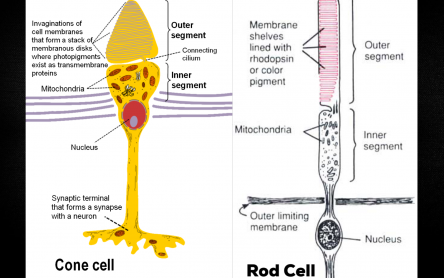 When we think about our vision or visible light, we often associate them with color perception. When our brains tell us whether we are seeing blue or red all depends on the wavelength, or energy level, of the photons that are hitting the back of our eye. Lining the insides of the back of our eye is a thin layer of tissue known as the retina. The retina has two types of special photoreceptor cells: concentrated in the center of the retina are cone cells and around the periphery of the retina are the rod cells. Cones allow us to perceive color and fine details while the rods allow us to see grayscales in low-light conditions. Retinal cells also contain a variety of those opsins that I mentioned earlier, and each is sensitive to the array of photons with different energy levels and wavelengths. As the photons bang into the retina, they generate an electrical impulse that then makes its way along the optic nerve to our brains, where the signal is decoded to register color and image detail. Since color perception is highly subjective, it is difficult to put a firm and fast number on how many shades of color we can discern but it surely must be tens of thousands, with many researchers citing a million.
When we think about our vision or visible light, we often associate them with color perception. When our brains tell us whether we are seeing blue or red all depends on the wavelength, or energy level, of the photons that are hitting the back of our eye. Lining the insides of the back of our eye is a thin layer of tissue known as the retina. The retina has two types of special photoreceptor cells: concentrated in the center of the retina are cone cells and around the periphery of the retina are the rod cells. Cones allow us to perceive color and fine details while the rods allow us to see grayscales in low-light conditions. Retinal cells also contain a variety of those opsins that I mentioned earlier, and each is sensitive to the array of photons with different energy levels and wavelengths. As the photons bang into the retina, they generate an electrical impulse that then makes its way along the optic nerve to our brains, where the signal is decoded to register color and image detail. Since color perception is highly subjective, it is difficult to put a firm and fast number on how many shades of color we can discern but it surely must be tens of thousands, with many researchers citing a million.
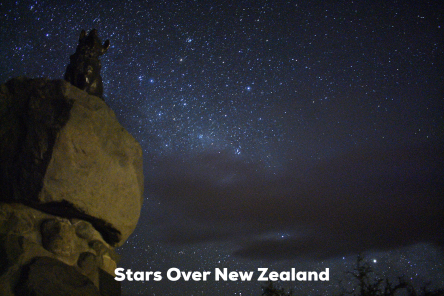 When it comes to stargazing it’s the rods that are running the show. Cones work mostly during the day but if you are looking at a celestial object with a high enough illumination level, they can still contribute (i.e. Mars registers as an orange-red while, in a telescope, you can see the earth-toned belts of Jupiter, and bright stars such as Sirius and Betelgeuse show colors as well). The key thing to know here is that as long as the object is capable of zapping your retina with a photon, you can, theoretically see it. Stop and consider the implications of this: it doesn’t matter how small or how far away something is from you, if it can transfer a photon to your eye, you can detect it.
When it comes to stargazing it’s the rods that are running the show. Cones work mostly during the day but if you are looking at a celestial object with a high enough illumination level, they can still contribute (i.e. Mars registers as an orange-red while, in a telescope, you can see the earth-toned belts of Jupiter, and bright stars such as Sirius and Betelgeuse show colors as well). The key thing to know here is that as long as the object is capable of zapping your retina with a photon, you can, theoretically see it. Stop and consider the implications of this: it doesn’t matter how small or how far away something is from you, if it can transfer a photon to your eye, you can detect it.
Step outside on a good, dark night and look at all of those stars overhead. By just glancing at them you can’t really tell how far away they are, but they are placed at such tremendous distances from the Earth that astronomers must use a distance unit less cumbersome than miles or kilometers: the light year. One light year is the distance that a photon would travel in one year’s time through the vacuum of space. That comes out to about 6 trillion miles. The closest star system to Earth that you can see with the unaided eye is that of Alpha Centauri, relatively close at a mere 4.4 light years (using the fastest propulsion system we now have it would be a journey of many thousands of years before you could get there). Compare that with Deneb, currently visible in our night sky within the constellation of Cygnus, and which lies at around 1,550 light years away. The most distant naked eye star puts even Deneb to shame. It’s known as Rho Cassiopeiae and can be found in the familiar W-pattern of stars that make up the constellation of Cassiopeia. Rho is estimated to be a whopping 8,200 light years away and even though it looks tiny and insignificant to your eye, you should know that its girth is 40% larger than the entire orbit of Mars around the Sun. And this is an important consideration: most of the stars you can see with your unaided eye are larger than our own Sun, some of them with diameters measured in millions of miles (the Sun is just a bit shy of having a diameter of one million miles). Even though they are many trillions of miles distant, they are still bright enough, given their huge sizes, to emit enough photons for the rods in our eyes to detect them.
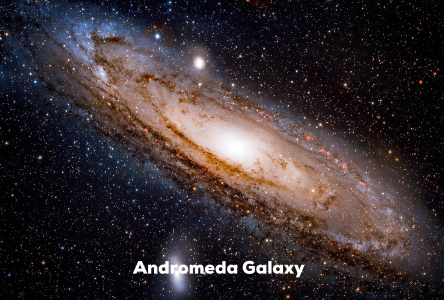 All these stars that you see are to be found within our Milky Way Galaxy. The Sun and all its family of planets, asteroids, and comets, comprise the solar system and virtually all the stars in our night sky are their own stellar system of planets and minor bodies. Estimates of the number of stars in the Milky Way range from 100 to 400 billion and together we all exist within a single galaxy. But there are many billions more galaxies in the whole shebang that we call the Universe. They all lie at such tremendous distances from us that we cannot see them with the naked eye. All but one that is. Right now, if you go outside during these late summer and fall evenings, look off to the NE at around 10pm. If your skies are dark enough and you know precisely where to look, you can just barely see a dim, fuzzy cloud of light. This faint and fuzzy patch of light is the Andromeda Galaxy, and it is the most distant object that you can see with your unaided eye at some 2.5 MILLION light years away. At that distance your eye cannot resolve the individual stars that comprise the galaxy and all that we can perceive is their total combined glow. Think about that, the galaxy is quintillions of miles away and yet there are enough photons getting into your eye, having traveled for some 2.5 million years, before they smashed into your retina, got converted into an electrical signal, which your brain could then decipher as a faint cloud of light upon the sky. And now, because you have read this (assuming you didn’t already know about it), your brain can allow you to put the sight into its proper context. You’re welcome.
All these stars that you see are to be found within our Milky Way Galaxy. The Sun and all its family of planets, asteroids, and comets, comprise the solar system and virtually all the stars in our night sky are their own stellar system of planets and minor bodies. Estimates of the number of stars in the Milky Way range from 100 to 400 billion and together we all exist within a single galaxy. But there are many billions more galaxies in the whole shebang that we call the Universe. They all lie at such tremendous distances from us that we cannot see them with the naked eye. All but one that is. Right now, if you go outside during these late summer and fall evenings, look off to the NE at around 10pm. If your skies are dark enough and you know precisely where to look, you can just barely see a dim, fuzzy cloud of light. This faint and fuzzy patch of light is the Andromeda Galaxy, and it is the most distant object that you can see with your unaided eye at some 2.5 MILLION light years away. At that distance your eye cannot resolve the individual stars that comprise the galaxy and all that we can perceive is their total combined glow. Think about that, the galaxy is quintillions of miles away and yet there are enough photons getting into your eye, having traveled for some 2.5 million years, before they smashed into your retina, got converted into an electrical signal, which your brain could then decipher as a faint cloud of light upon the sky. And now, because you have read this (assuming you didn’t already know about it), your brain can allow you to put the sight into its proper context. You’re welcome.
The rod cells in your retina use a photopigment known as “rhodopsin” and it is key to your ability to see in the dark and to perceive all of the awe and wonder of the night sky. When you step outside at night from a brightly lit room and into the darkness, your eye begins to undergo a two-step process known as “dark adaptation” allowing you to see in the low light conditions. The first step is purely physical, and it involves muscles that control the diameter of your pupils. During the day, or in any kind of bright light conditions, our pupils close to a diameter of around 2mm. This controls the amount of light entering the eye, too much light will damage the retina, hindering our ability to see or, in worse case scenarios, even blinding us. But under low light conditions, the pupils will suddenly expand to gather as much light as possible. In younger people the pupils will expand to as much as 7mm while in older folks like me, they will only increase in size to about 5mm. This expansion of the pupils increases the amount of light entering the eye by a factor of some 10 times.
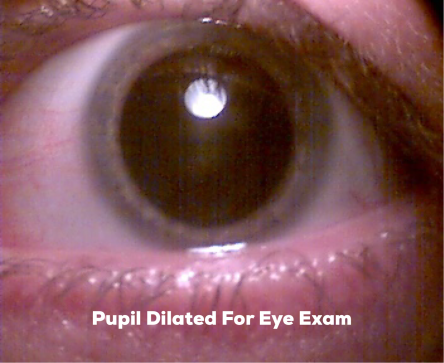 The dilation of your pupils is a response that occurs in seconds while the next step takes up to 20 minutes to complete. This second step involves the retina and its rod cells. After being in the dark for a long enough time, the rods begin to produce rhodopsin, the light sensitive pigment that makes your night vision work. You may have noticed that upon entering a dark room after being in a well lit one, that you cannot see much of anything at first but, after awhile you slowly begin to make out the things in the room you might bump into and bruise your shin or stub your toe on. The same thing will happen as you sit outside at night long enough. After leaving the comfort of your brightly lit living room, the darkness outside can be intimidating because of the difficulty in seeing things. But after a while, objects around you come into view. If you are looking up when you first step outside, you probably won’t see anything but the brightest stars, but within about 15 or 20 minutes, you notice that the sky is filled with many fainter stars. At this point, your dark adaptation is complete, and you are ready to take in the starry night in all its glory. But whatever you do, do not let any bright light hit your eye. Looking into car headlights, a flashlight, bright house, or streetlights, or even the bright light from your cell phone will destroy your dark adaptation in a second. Why? Because rhodopsin is a light sensitive pigment, and it has a threshold beyond which it will suddenly break down when exposed to enough light. Astronomers are very sensitive about the use of bright lights at an observing site, and you can expect to get yelled at if you ever find yourself at such a location and you turn on your cell phone flashlight in order to see around. The best way to preserve your night vision (and that of the cranky astronomers), and still see in the dark, is to use a red LED flashlight or, a regular old flashlight with red plastic film taped over the lens. Why red light? Red light has a longer wavelength and lower energy than does bluer light and the longer wavelength doesn’t really do any harm to the rhodopsin that your rods slaved over for 20 minutes to make. Each time you let your eye get hit by bright light, the longer it takes to get dark adapted all over again.
The dilation of your pupils is a response that occurs in seconds while the next step takes up to 20 minutes to complete. This second step involves the retina and its rod cells. After being in the dark for a long enough time, the rods begin to produce rhodopsin, the light sensitive pigment that makes your night vision work. You may have noticed that upon entering a dark room after being in a well lit one, that you cannot see much of anything at first but, after awhile you slowly begin to make out the things in the room you might bump into and bruise your shin or stub your toe on. The same thing will happen as you sit outside at night long enough. After leaving the comfort of your brightly lit living room, the darkness outside can be intimidating because of the difficulty in seeing things. But after a while, objects around you come into view. If you are looking up when you first step outside, you probably won’t see anything but the brightest stars, but within about 15 or 20 minutes, you notice that the sky is filled with many fainter stars. At this point, your dark adaptation is complete, and you are ready to take in the starry night in all its glory. But whatever you do, do not let any bright light hit your eye. Looking into car headlights, a flashlight, bright house, or streetlights, or even the bright light from your cell phone will destroy your dark adaptation in a second. Why? Because rhodopsin is a light sensitive pigment, and it has a threshold beyond which it will suddenly break down when exposed to enough light. Astronomers are very sensitive about the use of bright lights at an observing site, and you can expect to get yelled at if you ever find yourself at such a location and you turn on your cell phone flashlight in order to see around. The best way to preserve your night vision (and that of the cranky astronomers), and still see in the dark, is to use a red LED flashlight or, a regular old flashlight with red plastic film taped over the lens. Why red light? Red light has a longer wavelength and lower energy than does bluer light and the longer wavelength doesn’t really do any harm to the rhodopsin that your rods slaved over for 20 minutes to make. Each time you let your eye get hit by bright light, the longer it takes to get dark adapted all over again.  And by the way, vitamin A is a precursor to rhodopsin. Your body can convert vitamin A from beta carotene. A great source for beta carotene is carrots. Our mommas might not have always been right when giving out life advice but if yours ever told you to eat all your carrots so that you could see better, she was spot on.
And by the way, vitamin A is a precursor to rhodopsin. Your body can convert vitamin A from beta carotene. A great source for beta carotene is carrots. Our mommas might not have always been right when giving out life advice but if yours ever told you to eat all your carrots so that you could see better, she was spot on.
Isn’t it amazing how those delicate globes of tissue stuck into the front of your skull, in combination with the firm 3lb mass of gray matter inside your cranium, conspire together to allow us to appreciate the aesthetic beauty of the night sky, ponder over what it all means, and to ultimately understand our place in a vast, ever-expanding universe?